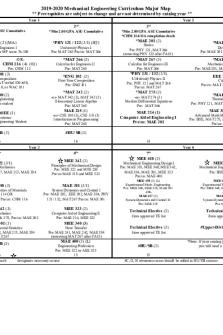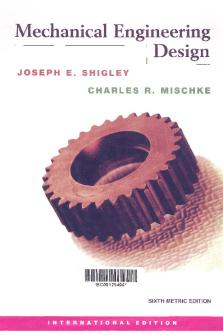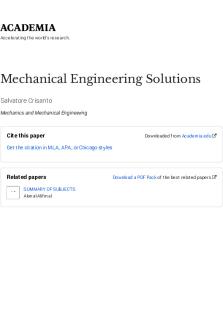Ashrae-62.1-2019 - mechanical engineering PDF

| Title | Ashrae-62.1-2019 - mechanical engineering |
|---|---|
| Author | Ryan Francis Yadao |
| Course | Mechanical Engineering |
| Institution | Mariano Marcos State University |
| Pages | 92 |
| File Size | 2.4 MB |
| File Type | |
| Total Downloads | 63 |
| Total Views | 150 |
Summary
mechanical engineering...
Description
ANSI/ASHRAE Standard 62.1-2019 (Supersedes ANSI/ASHRAE Standard 62.1-2016) Includes ANSI/ASHRAE addenda listed in Appendix O
Ventilation for Acceptable Indoor Air Quality
See Appendix O for approval dates by ASHRAE and the American National Standards Institute.
This Standard is under continuous maintenance by a Standing Standard Project Committee (SSPC) for which the Standards Committee has established a documented program for regular publication of addenda or revisions, including procedures for timely, documented, consensus action on requests for change to any part of the Standard. Instructions for how to submit a change can be found on the ASHRAE
®
website (www.ashrae.org/continuous-maintenance).
The latest edition of an ASHRAE Standard may be purchased from the ASHRAE website (www.ashrae.org) or from ASHRAE Customer Service, 1791 Tullie Circle, NE, Atlanta, GA 30329-2305. E-mail: [email protected]. Fax: 678-5392129. Telephone: 404-636-8400 (worldwide), or toll free 1-800-527-4723 (for orders in US and Canada). For reprint permission, go to www.ashrae.org/permissions.
© 2019 ASHRAE
ISSN 1041-2336
ASHRAE Standing Standard Project Committee 62.1 Cognizant TC: 4.3, Ventilation Requirements and Infiltration SPLS Liaison: Karl L. Peterman ASHRAE Staff Liaison: Mark Weber Jennifer A. Isenbeck, Chair (2019), Co-Vice-Chair (2017–2019) Hoy R. Bohanon, Jr., Chair (2016–2019) Wayne R. Thomann, Vice-Chair (2019), Co-Vice-Chair (2017–2019)
Henry W. Ernst, Jr.
Meghan K. McNulty
Hugo Aguilar
Nick H. Agopian
Richard B. Fox
Maria A. Menchaca Brandan
William P. Bahnfleth
Enrica Galasso
Christopher O. Muller
Charlene W. Bayer Robin M. Bristol Lance R. Brown Tina M. Brueckner Brendon J. Burley
Elliott Gall
John Nelson, Jr.
Enrique T. Gonzalez
Lisa C. Ng Laura G. Petrillo-Groh Daniel C. Pettway
Ted Wayne
Nathan L. Ho
Heather L. Platt Gulledge
Josiah Wiley
Elliott Horner
Stephen Ray
Eli P. Howard, III
Daniel J. Redmond
Helen D. Davis James E. Dennison Paul L. Doppel
Richard Taft Dean T. Tompkins
Gregg Gress
Jordan D. Clark
Abdel K. Darwich
Erica Stewart Drayton P. Stott
Brian J. Hafendorfer
Mark P. Buttner
Leonard A. Damiano
Dennis A. Stanke
Zalmie Hussein
Tom Rice
Jennifer Kane
Chandra Sekhar
Paul J. Kitchens
Charles J. Seyffer
Lauren MacGowens
Abhinav Shukla
Stephany I. Mason
Jeffrey K. Smith
David Vigue
Scott D. Williams Donald Weekes, Jr. Runming Yao Marwa Zaatari
ASHRAE STANDARDS COMMITTEE 2019–2020 Wayne H. Stoppelmoor, Jr., Chair
Susanna S. Hanson
Drury B. Crawley, Vice-Chair
Lawrence J. Schoen
Rick M. Heiden
Els Baert
Jonathan Humble
Charles S. Barnaby
Steven C. Sill Richard T. Swierczyna
Srinivas Katipamula
Niels Bidstrup
Christian R. Taber
Essam E. Khalil
Robert B. Burkhead
Russell C. Tharp
Kwang Woo Kim
Thomas E. Cappellin
Larry Kouma
Douglas D. Fick
Cesar L. Lim
Michael W. Gallagher
Karl L. Peterman
Walter T. Grondzik
Erick A. Phelps
Adrienne G. Thomle Michael W. Woodford Craig P. Wray Jaap Hogeling, BOD ExO Malcolm D. Knight, CO
Steven C. Ferguson, Senior Manager of Standards
SPECIAL NOTE This American National Standard (ANS) is a national voluntary consensus Standard developed under the auspices of ASHRAE. Consensus is defined by the American National Standards Institute (ANSI), of which ASHRAE is a member and which has approved this Standard as an ANS, as “substantial agreement reached by directly and materially affected interest categories. This signifies the concurrence of more than a simple majority, but not necessarily unanimity. Consensus requires that all views and objections be considered, and that an effort be made toward their resolution.” Compliance with this Standard is voluntary until and unless a legal jurisdiction makes compliance mandatory through legislation. ASHRAE obtains consensus through participation of its national and international members, associated societies, and public review. ASHRAE Standards are prepared by a Project Committee appointed specifically for the purpose of writing the Standard. The Project Committee Chair and Vice-Chair must be members of ASHRAE; while other committee members may or may not be ASHRAE members, all must be technically qualified in the subject area of the Standard. Every effort is made to balance the concerned interests on all Project Committees. The Senior Manager of Standards of ASHRAE should be contacted for a. interpretation of the contents of this Standard, b. participation in the next review of the Standard, c. offering constructive criticism for improving the Standard, or d. permission to reprint portions of the Standard.
DISCLAIMER ASHRAE uses its best efforts to promulgate Standards and Guidelines for the benefit of the public in light of available information and accepted industry practices. However, ASHRAE does not guarantee, certify, or assure the safety or performance of any products, components, or systems tested, installed, or operated in accordance with ASHRAE’s Standards or Guidelines or that any tests conducted under its Standards or Guidelines will be nonhazardous or free from risk.
ASHRAE INDUSTRIAL ADVERTISING POLICY ON STANDARDS ASHRAE Standards and Guidelines are established to assist industry and the public by offering a uniform method of testing for rating purposes, by suggesting safe practices in designing and installing equipment, by providing proper definitions of this equipment, and by providing other information that may serve to guide the industry. The creation of ASHRAE Standards and Guidelines is determined by the need for them, and conformance to them is completely voluntary. In referring to this Standard or Guideline and in marking of equipment and in advertising, no claim shall be made, either stated or implied, that the product has been approved by ASHRAE.
CONTENTS ANSI/ASHRAE Standard 62.1-2019 Ventilation for Acceptable Indoor Air Quality SECTION
PAGE
Foreword .....................................................................................................................................................................2 1 Purpose.............................................................................................................................................................2 2 Scope ................................................................................................................................................................3 3 Definitions .........................................................................................................................................................3 4 Outdoor Air Quality............................................................................................................................................6 5 Systems and Equipment ...................................................................................................................................7 6 Procedures......................................................................................................................................................15 7 Construction and System Start-Up..................................................................................................................30 8 Operations and Maintenance ..........................................................................................................................31 9 Normative References ....................................................................................................................................34 Normative Appendix A: Multiple-Zone System Ventilation Efficiency: Alternative Procedure ...............................36 Normative Appendix B: Separation of Exhaust Outlets and Outdoor Air Intakes..................................................40 Normative Appendix C: Zone Air Distribution Effectiveness: Alternate Procedures..............................................43 Informative Appendix D: Information on Selected National Standards and Guidelines for PM10, PM2.5, and Ozone .................................................................................................................45 Informative Appendix E: Acceptable Mass Balance Equations for Use with the IAQ Procedure ..........................47 Informative Appendix F: Simplified Ventilation Rate Calculation for Multiple-Zone Recirculating Systems Serving Only Specified Occupancy Categories in Existing Buildings ...............................................49 Informative Appendix G: Application .....................................................................................................................51 Informative Appendix H: Documentation...............................................................................................................53 Informative Appendix I: Rate Rationale.................................................................................................................56 Informative Appendix J: Information on Natural Ventilation ..................................................................................64 Informative Appendix K: Compliance ....................................................................................................................67 Informative Appendix L: Ventilation Rate Check Table .........................................................................................71 Informative Appendix M: Informative References .................................................................................................75 Informative Appendix N: Indoor Air Quality Procedure (IAQP)..............................................................................76 Informative Appendix O: Addenda Description Information ..................................................................................81
© 2019 ASHRAE 1791 Tullie Circle NE · Atlanta, GA 30329 · www.ashrae.org · All rights reserved. ASHRAE is a registered trademark of the American Society of Heating, Refrigerating and Air-Conditioning Engineers, Inc. ANSI is a registered trademark of the American National Standards Institute.
(This foreword is not part of this standard. It is merely informative and does not contain requirements necessary for conformance to the standard. It has not been processed according to the ANSI requirements for a standard and may contain material that has not been subject to public review or a consensus process. Unresolved objectors on informative material are not offered the right to appeal at ASHRAE or ANSI.) FOREWORD Standard 62.1 has undergone key changes over the years, reflecting the ever-expanding body of knowledge, experience, and research related to ventilation and air quality. While the purpose of the standard remains unchanged—to specify minimum ventilation rates and other measures intended to provide indoor air quality (IAQ) that is acceptable to human occupants and that minimizes adverse health effects—the means of achieving this goal have evolved. In its first edition, the standard adopted a prescriptive approach to ventilation by specifying both minimum and recommended outdoor airflow rates to obtain acceptable indoor air quality for a variety of indoor spaces. In 1981, the standard reduced minimum outdoor airflow rates and introduced an alternative performance-based approach, the IAQ Procedure, which allowed for the calculation of the amount of outdoor air necessary to maintain the levels of indoor air contaminants below recommended limits. In 2004—the last time the standard was revised in its entirety—the IAQ Procedure was modified to improve enforceability, but more significantly the Ventilation Rate Procedure was modified, changing both the minimum outdoor airflow rates and the procedures for calculating both zone-level and system-level outdoor airflow rates. Today, the standard includes three procedures for ventilation design: the IAQ Procedure, the Ventilation Rate Procedure, and the Natural Ventilation Procedure. The following are among significant changes made in the 2019 edition of the standard: • The scope is changed to remove commentary and to more specifically identify occupancies previously not covered. • Informative tables of ventilation rates per unit area are included for checking existing buildings and design of new buildings. • The Ventilation Rate Procedure is modified with a new simplified version for determining Ev and a more robust option for determining values of Ez . • The Natural Ventilation Procedure is significantly modified to provide a more accurate calculation methodology and also define the process for designing an engineered system. • Natural ventilation now requires considering the quality of the outdoor air and interaction of the outdoor air with mechanically cooled spaces. • Air-cleaning devices that generate ozone are prohibited. • Humidity control requirements are now expressed as dew point and not as relative humidity. • The standard now defers to ANSI Z9.5 on ventilation for laboratories handling hazardous materials. • Patient care spaces in the scope of ASHRAE/ASHE Standard 170 now follow the requirements of Standard 170; ancillary spaces not previously classified have been added. For more specific information on these and other changes made to the standard, refer to Informative Appendix O. Standard 62.1 is updated on a regular basis using ASHRAE's continuous maintenance procedures. Addenda are publicly reviewed, approved by ASHRAE and ANSI, and posted on the ASHRAE website. Change proposals can be submitted online at www.ashrae.org/continuous-maintenance. The project committee for Standard 62.1 takes formal action on all change proposals received. 1. PURPOSE 1.1 The purpose of this standard is to specify minimum ventilation rates and other measures intended to provide indoor air quality (IAQ) that is acceptable to human occupants and that minimizes adverse health effects. 1.2 This standard is intended for regulatory application to new buildings, additions to existing buildings, and those changes to existing buildings that are identified in the body of the standard. 1.3 This standard is intended to be used to guide the improvement of IAQ in existing buildings. 2
ANSI/ASHRAE Standard 62.1-2019
2. SCOPE 2.1 This standard applies to spaces intended for human occupancy within buildings except those within dwelling units in residential occupancies in which occupants are nontransient. 2.2 This standard defines requirements for ventilation and air-cleaning system design, installation, commissioning, and operation and maintenance. 2.3 In addition to ventilation, this standard contains requirements related to certain contaminants and contaminant sources, including outdoor air, construction processes, moisture, and biological growth. 2.4 This standard does not prescribe specific ventilation rate requirements for the following: a. Spaces that contain smoking or that do not meet the requirements in the standard for separation from spaces that contain smoking b. Patient care areas not listed in this standard c. Laboratories with hazardous materials 3. DEFINITIONS 3.1 Terminology (See Figure 3-1) acceptable indoor air quality (IAQ): air in which there are no known contaminants at harmful concentrations, as determined by cognizant authorities, and with which a substantial majority (80% or more) of the people exposed do not express dissatisfaction. air: ambient air: the air surrounding a building; the source of outdoor air brought into a building. cool air: air whose temperature is less than the average space temperature. exhaust air: air removed from a space and discharged to outside the building by means of mechanical or natural ventilation systems. indoor air: the air in an enclosed occupiable space. makeup air: any combination of outdoor and transfer air intended to replace exhaust air and exfiltration. outdoor air: ambient air and ambient air that enters a building through a ventilation system, through intentional openings for natural ventilation, or by infiltration. primary air: air supplied to the ventilation zone prior to mixing with any locally recirculated air. recirculated air: air removed from a space and reused as supply air. return air: air removed from a space to be recirculated or exhausted. supply air: air delivered by mechanical or natural ventilation to a space and composed of any combination of outdoor air, recirculated air, or transfer air. transfer air: air moved from one indoor space to another. ventilation air: that portion of supply air that is outdoor air plus any recirculated air that has been treated for the purpose of maintaining acceptable IAQ. warm air: air whose temperature is greater than the average space temperature. air-cleaning system: a device or combination of devices applied to reduce the concentration of airborne contaminants such as microorganisms, dusts, fumes, respirable particles, other particulate matter, gases, vapors, or any combination thereof. air conditioning: the process of treating air to meet the requirements of a conditioned space by controlling its temperature, humidity, cleanliness, and distribution. breathing zone: the region within an occupied space between planes 3 and 72 in. (75 and 1800 mm) above the floor and more than 2 ft (600 mm) from the walls or fixed air-conditioning equipment. ceiling return: air removed from the space more than 4.5 ft (1.4 m) above the floor. ceiling supply: air supplied to the space more than 4.5 ft (1.4 m) above the floor. ANSI/ASHRAE Standard 62.1-2019
3
Figure 3-1 Ventilation system.
classroom: a space for instruction in which the instructor regularly occupies and stores supplies in the space. lecture classroom: a space for instruction in which all occupants are interim and no supplies are stored in the space. cognizant authority: an agency or organization that has the expertise and jurisdiction to establish and regulate concentration limits for airborne contaminants, or an agency or organization that is recognized as authoritative and has the scope and expertise to establish guidelines, limit values, or concentrations levels for airborne contaminants. concentration: the quantity of one constituent dispersed in a defined amount of another. conditioned space: that part of a building that is heated or cooled or both for the comfort of occupants. contaminant: an unwanted airborne constituent with the potential to reduce acceptability of the air. contaminant mixture: two or more contaminants that target the same organ system. demand controlled ventilation (DCV): any means by which the breathing zone outdoor airflow (Vbz) can be varied to the occupied space or spaces based on the actual or estimated number of occupants, ventilation requirements of the occupied zone, or both. dwelling unit: a single unit providing complete, independent living facilities for one or more persons, including permanent provisions for living, sleeping, eating, cooking, and sanitation. energy recovery ventilation system: a device or combination of devices applied to provide the outdoor air for ventilation in which energy is transferred between the intake and exhaust airstreams. environmental tobacco smoke (ETS): the “aged” and diluted combination of both side-stream smoke (smoke from the lit end of a cigarette or other tobacco product) and exhaled mainstre...
Similar Free PDFs

Mechanical-engineering
- 1 Pages

Mechanical engineering
- 1 Pages

2019-2020 Mechanical Engineering
- 2 Pages

Mechanical Engineering Circuits
- 10 Pages

MECHANICAL ENGINEERING REVIEW MANUAL
- 509 Pages

Mechanical engineering lab report
- 18 Pages

Mechanical Engineering Lecture Notes
- 13 Pages

MECHANICAL ENGINEERING REVIEW MANUAL
- 509 Pages

Mechanical Engineering Elements
- 29 Pages

Mechanical engineering design
- 6 Pages

Mechanical Engineering Solutions
- 21 Pages

Mechanical Engineering Level M
- 16 Pages
Popular Institutions
- Tinajero National High School - Annex
- Politeknik Caltex Riau
- Yokohama City University
- SGT University
- University of Al-Qadisiyah
- Divine Word College of Vigan
- Techniek College Rotterdam
- Universidade de Santiago
- Universiti Teknologi MARA Cawangan Johor Kampus Pasir Gudang
- Poltekkes Kemenkes Yogyakarta
- Baguio City National High School
- Colegio san marcos
- preparatoria uno
- Centro de Bachillerato Tecnológico Industrial y de Servicios No. 107
- Dalian Maritime University
- Quang Trung Secondary School
- Colegio Tecnológico en Informática
- Corporación Regional de Educación Superior
- Grupo CEDVA
- Dar Al Uloom University
- Centro de Estudios Preuniversitarios de la Universidad Nacional de Ingeniería
- 上智大学
- Aakash International School, Nuna Majara
- San Felipe Neri Catholic School
- Kang Chiao International School - New Taipei City
- Misamis Occidental National High School
- Institución Educativa Escuela Normal Juan Ladrilleros
- Kolehiyo ng Pantukan
- Batanes State College
- Instituto Continental
- Sekolah Menengah Kejuruan Kesehatan Kaltara (Tarakan)
- Colegio de La Inmaculada Concepcion - Cebu



